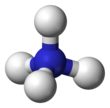Ammonium hexafluorophosphate
Appearance

| |||
| |||
| Names | |||
|---|---|---|---|
| IUPAC name
ammonium hexafluorophosphate
| |||
| Identifiers | |||
3D model (JSmol)
|
|||
| ChemSpider | |||
| ECHA InfoCard | 100.037.266 | ||
| EC Number |
| ||
PubChem CID
|
|||
| UNII | |||
CompTox Dashboard (EPA)
|
|||
| |||
| |||
| Properties | |||
| (NH4)[PF6] | |||
| Molar mass | 163.00264 | ||
| Appearance | white solid | ||
| Density | 2.180 g/cm3 | ||
| 74.8 g/100 mL(20 °C) | |||
| Hazards | |||
| GHS labelling: | |||

| |||
| Danger | |||
| H314 | |||
| P260, P264, P280, P301+P330+P331, P303+P361+P353, P304+P340, P305+P351+P338, P310, P321, P363, P405, P501 | |||
| Safety data sheet (SDS) | Oxford MSDS | ||
Except where otherwise noted, data are given for materials in their standard state (at 25 °C [77 °F], 100 kPa).
| |||
Ammonium hexafluorophosphate is the inorganic compound with the formula NH4PF6. It is a white water-soluble, hygroscopic solid. The compound is a salt consisting of the ammonium cation and hexafluorophosphate anion. It is commonly used as a source of the hexafluorophosphate anion, a weakly coordinating anion. It is prepared by combining neat ammonium fluoride and phosphorus pentachloride. Alternatively it can also be produced from phosphonitrilic chloride:[1]
- PCl5 + 6 NH4F → NH4PF6 + 5 NH4Cl
- PNCl2 + 6 HF → NH4PF6 + 2 HCl
References
[edit]- ^ W. Kwasnik (1963). "Ammonium Hexafluorophosphate (V)". In G. Brauer (ed.). Handbook of Preparative Inorganic Chemistry, 2nd Ed. Vol. 1. NY, NY: Academic Press. pp. 195–196.


